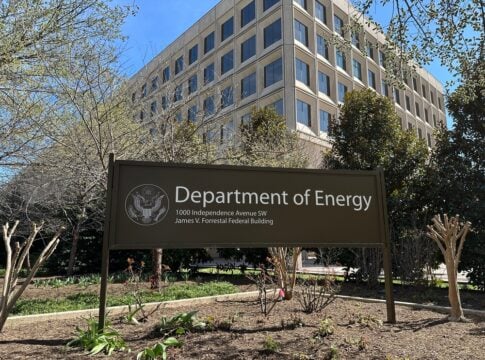Carbon credit projects are gaining significant attention as businesses aim to reduce greenhouse gas (GHG) emissions while maintaining profitability. These projects offer a pathway for companies to offset emissions, improve sustainability, and tap into new revenue streams.
But how do they do that? This guide explores the types, benefits, challenges, and future trends of carbon credit projects, helping businesses navigate this critical climate solution.
5 Key Types of Carbon Credit Projects
Carbon credit projects include a range of activities designed to either reduce or capture GHG emissions. Here are the five primary types, each with specific mechanisms and benefits:
1. Reforestation & Afforestation
Reforestation involves replanting trees in deforested areas, while afforestation refers to planting trees in regions that have not been forested for extended periods. These projects sequester carbon dioxide (CO₂) from the atmosphere as trees absorb CO₂ during photosynthesis, storing carbon in their biomass and soil.

Reforestation and afforestation projects continue to play a crucial role in carbon sequestration. Some large-scale reforestation projects are financially backed by multinational corporations such as this Amazon reforestation initiative by Mombak.
However, there are also a lot of small nature conservation projects worldwide that need funding to scale up. Some of them are still in the development stage but offer innovative approaches to reforesting degraded lands.
One example in Asia is a re-greening project that aims to reforest hectares of deforested land. Using innovative seed ball technology and drone deployment, the project will disperse seeds across vast areas, promoting large-scale forest restoration. This initiative will not only sequester CO₂ but also support local biodiversity and provide economic opportunities for surrounding communities.
Reforestation and afforestation projects are pivotal in global carbon sequestration efforts. According to the Food and Agriculture Organization (FAO), forests absorb approximately 2.6 billion tonnes of CO₂ annually. This figure offsets about ⅓ of the CO₂ released from burning fossil fuels. Such projects also contribute to biodiversity conservation, soil preservation, and the enhancement of water resources.
2. Renewable Energy Projects
Renewable energy projects involve the development of energy sources that do not emit GHGs during operation. Common examples are wind, solar, and hydroelectric power. By replacing fossil fuel-based energy generation, these projects significantly reduce CO₂ emissions.
Renewable energy projects remain a significant source of carbon credits. In 2024, renewable energy credits represented 31% of total retirements, with 51.1 million credits retired. This result indicates a continued commitment to clean energy initiatives.
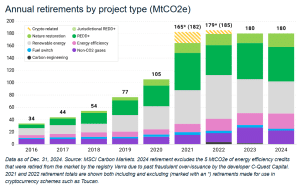
For instance, one of the world’s largest solar energy projects, the Noor Ouarzazate Solar Complex in Morocco covers 3,000 hectares. It has a total capacity of 580 MW, supplying power to over a million people. The project reduces CO₂ emissions by approximately 760,000 tonnes annually.
The Gansu Wind Farm in China is another example. It is one of the world’s largest wind power projects, with a planned capacity of 20 GW. Located in the Gobi Desert, it currently produces over 8 GW of electricity, powering millions of homes. The project reduces CO₂ emissions by millions of tonnes annually and plays a crucial role in China’s renewable energy expansion.
Since 2010, over 750 million voluntary carbon credits have been issued by over 1,700 renewable energy projects worldwide. Wind projects contribute 40% of these credits, followed by hydro (30%) and solar (15%). These projects play a crucial role in diversifying energy portfolios and reducing reliance on fossil fuels.
3. Methane Capture & Destruction
Methane (CH₄) is a potent GHG with a global warming potential about 28 times greater than that of CO₂ over a 100-year period. Projects that capture methane aim to collect and use or destroy methane emissions from sources like landfills, agricultural activities, and wastewater treatment facilities.
In the U.S., numerous landfill gas-to-energy projects have been established to capture methane produced by decomposing organic waste. The captured methane is then used to generate electricity or heat, thereby reducing GHG emissions and providing a renewable energy source.

As of 2024, the U.S. Environmental Protection Agency (EPA) reports 542 operational landfill gas (LFG) energy projects nationwide. These projects harness methane emissions from landfills to generate energy, thereby reducing GHG emissions and providing a renewable energy source.
One company, Zefiro Methane, focuses on sealing abandoned oil and gas wells across the U.S. to prevent methane leaks. By capping and properly decommissioning these wells, Zefiro reduces emissions and generates carbon credits that can be traded in voluntary markets. Their work supports climate goals while addressing the millions of abandoned wells contributing to methane pollution.
The Global Methane Pledge, launched in 2021, aims to reduce global methane emissions by at least 30% from 2020 levels by 2030. Achieving this target could reduce warming by at least 0.2°C by 2050, demonstrating the significant impact of methane capture initiatives.
4. Carbon Capture & Storage (CCS)
Carbon Capture and Storage (CCS) involves capturing CO₂ emissions from industrial processes or directly from the atmosphere and storing them underground in geological formations. This technology prevents CO₂ from entering the atmosphere, thereby mitigating climate change.
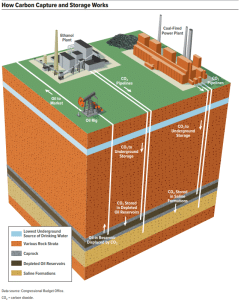
CCS technologies have seen advancements, with increased investments in projects aimed at capturing CO₂ emissions from industrial processes. In 2024, significant policy developments, including breakthroughs on Article 6 at COP29, are expected to shape the global market for carbon credits, potentially influencing the implementation of CCS projects.
A popular example of CCS is Northern Lights, a joint venture by Equinor, Shell, and TotalEnergies. It is a large-scale carbon capture and storage project in Norway.
- SEE MORE: The “Northern Lights” Shines: Shell, Equinor, and TotalEnergies JV Powers the Norway CCS Project
It captures CO₂ emissions from industrial sources, liquefies them, and transports them for permanent storage under the North Sea. The project aims to store up to 1.5 million tons of CO₂ annually in its first phase, with expansion plans for up to 5 million tons per year, helping industries decarbonize while generating carbon credits.
As of 2024, the global CCS landscape has seen significant growth. There are now 50 operational CCS facilities worldwide, capturing around 50 million tonnes of CO₂ annually. Additionally, 44 facilities are under construction, and 534 are in various stages of development, indicating a robust expansion in CCS initiatives.
The International Energy Agency (IEA) emphasizes that to achieve net-zero emissions by 2050, CCS capacity needs to increase to 1.6 billion tonnes of CO₂ annually by 2030.
5. Community & Land Management Initiatives
These projects focus on sustainable land use practices, conservation, and community-driven efforts to enhance carbon sequestration and support local economies.
Community-driven projects focusing on sustainable land management have been instrumental in generating carbon credits. These initiatives often involve agroforestry and conservation efforts that not only sequester carbon but also provide socio-economic benefits to local communities.
A great example is the Kasigau Corridor project protects over 200,000 hectares of dryland forest in southeastern Kenya. By preventing deforestation and promoting sustainable land management, the project has generated over 1 million carbon credits. It also provides employment opportunities, supports education, and funds community development initiatives, benefiting approximately 100,000 local people.
Community and land management projects are integral to the Reducing Emissions from Deforestation and Forest Degradation (REDD+) program under the United Nations Framework Convention on Climate Change (UNFCCC). These initiatives sequester carbon as well as promote biodiversity conservation and enhance the livelihoods of local communities
4 Benefits of Carbon Credit Projects for Businesses
Environmental Impact & Carbon Reduction
Participating in carbon credit projects enables businesses to offset their carbon footprint effectively. In 2023, global carbon pricing revenues reached a record $104 billion, reflecting increased corporate engagement in emission reduction initiatives.
Beyond compliance, carbon credit projects play a crucial role in meeting global climate goals. According to the IEA, the world must cut emissions by 45% by 2030 to limit global warming to 1.5°C. Businesses that invest in high-quality credits contribute to this target while mitigating their own climate risks and cutting carbon emissions.
Additionally, some programs, like REDD+ help protect biodiversity and improve land-use practices, making them doubly beneficial.
Financial Benefits & Revenue Streams
The carbon credit market has become a substantial financial avenue for businesses. In 2024, credits worth a total of $1.4 billion were utilized by corporations, underscoring the market’s potential for generating additional revenue streams.
Companies not only purchase credits to offset emissions but also develop their own projects to sell verified carbon offsets.
For instance, major corporations like Microsoft and Shell invest in carbon capture projects to generate high-value credits. According to Allied Market Research, the global voluntary carbon market is projected to reach $100 billion by 2030, presenting lucrative opportunities for businesses that engage early. While MSCI data suggests that voluntary carbon credit market could reach up to $250 billion by 2050.
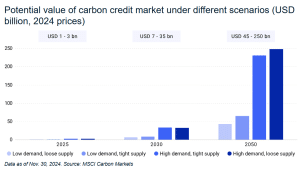
Enhancing Corporate Reputation
Engaging in carbon credit projects enhances a company’s reputation by demonstrating a commitment to sustainability. This proactive approach improves brand image and fosters customer loyalty, as consumers increasingly prefer environmentally responsible companies.
A 2023 survey by IBM found that 70% of consumers are willing to pay a premium for sustainable brands, highlighting the competitive advantage of climate-conscious business strategies.
Moreover, ESG (Environmental, Social, and Governance) investing has surged, with global ESG assets expected to surpass $40 trillion by 2025. Companies that actively reduce their carbon footprint through verified credit projects are more likely to secure funding from institutional ESG-focused investors.
Regulatory Compliance & Market Demand
With the implementation of stricter environmental regulations worldwide, carbon credits assist businesses in complying with emission targets. The expansion of carbon pricing instruments, now totaling 75 globally, indicates a growing market demand for sustainable practices.
Governments are tightening emission policies, making carbon credits a crucial tool for avoiding hefty fines and maintaining operations.
The European Union’s Carbon Border Adjustment Mechanism (CBAM), set to be fully implemented by 2026, will require importers to pay for embedded emissions in products like steel and cement. Similarly, the U.S. Inflation Reduction Act (IRA) includes billions in incentives for clean energy projects and carbon capture. These policies create a clear incentive for companies to invest in carbon credits to maintain regulatory compliance and gain a competitive edge.
3 Steps To Implementing A Successful Carbon Credit Project
If you’re planning or simply thinking about how to have a carbon credit project that emerges successfully, here are the three major steps to follow:
1. Identifying Project Scope & Goals
Start by defining your carbon credit project’s objectives. What are you aiming to achieve? This could range from reducing carbon emissions to generating new revenue streams or ensuring compliance with regulatory frameworks. Each objective should be clear and measurable to track progress.
Once your goals are set, choose the right project type. Whether it’s reforestation, renewable energy generation, or methane capture, aligning your project’s nature with your goals is essential. For instance, if emission reductions are a priority, a renewable energy project may be the best fit. Careful selection of the project type will streamline efforts and maximize impact.
2. Verifying Carbon Offset Credits & Certification
Next, focus on obtaining certification for the carbon credits you generate. Certification from established, recognized standards—such as the Gold Standard or Verra—validates the legitimacy of your carbon credits. Stick to proven methodologies and ensure full transparency in your project’s implementation.
Rigorous monitoring and reporting will ensure that your carbon credits are verified correctly and gain credibility in the marketplace. Remember, the higher the standard of certification, the more trustworthy your credits will appear to buyers, enhancing their marketability.

3. Market Engagement & Carbon Credit Trading
Finally, engage with carbon credit trading platforms to bring your credits to market. Established marketplaces, such as those launched by governments or private entities, allow for easy buying and selling of carbon credits. For example, Indonesia’s entry into the global carbon market in 2024 was a significant step toward green energy funding.
By listing your credits on such platforms, you can contribute to the global effort against climate change while monetizing your efforts. The carbon trading landscape is growing, making it crucial for businesses to stay informed and ready to leverage these platforms for maximum impact.
5 Challenges in Managing Carbon Credit Projects
After knowing the benefits of and the steps needed to implement a carbon credit project, it’s also wise to learn the challenges involved.
-
Ensuring Project Validity & Monitoring
Rigorous monitoring and validation are necessary to maintain project integrity and avoid issues like double counting. This ensures that emission reductions are genuinely achieved.
-
Avoiding Double Counting
Implementing robust tracking systems is crucial to prevent the same carbon credit from being counted multiple times, preserving the credibility of carbon offset claims.
-
Managing Volatile Market Prices
The carbon credit market can experience price fluctuations, impacting the financial sustainability of projects. Staying informed about market trends and diversifying project portfolios can help mitigate these risks. Go over this carbon price page to stay informed.
-
Meeting Strict Regulatory Standards
Compliance with evolving environmental regulations requires businesses to stay updated. Engaging with policy developments, like the breakthroughs in Article 6 at COP29 in 2024, ensures projects align with international standards.
-
Securing Long-Term Financing
Attracting and maintaining investment for carbon credit projects can be challenging. However, by the end of the third quarter of 2024, $14 billion had been raised or committed, reflecting increasing investor interest and confidence in the market.
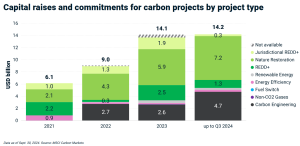
3 Future Trends in Carbon Credit Projects
Finally, it helps to know what trends are unfolding in the market and learn how to leverage them, namely:
Innovations in Carbon Capture Technologies
As carbon capture technologies evolve, they are expected to significantly improve the efficiency and scalability of emission reduction efforts. Innovations like Direct Air Capture (DAC) are poised to capture carbon dioxide directly from the atmosphere, making it easier to offset emissions from difficult-to-decarbonize sectors.
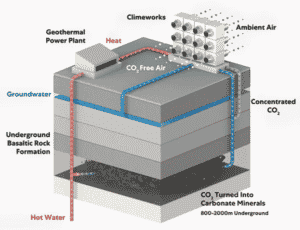
These advancements will drive the development of high-quality carbon credit projects that can scale rapidly to meet global climate goals. The global carbon capture market could reach $7.3 billion by 2030, highlighting its growing potential as a major player in carbon credit generation.
Expansion of Carbon Credit Marketplaces
The emergence of new carbon credit marketplaces is a key trend shaping the future of carbon trading. Platforms like Indonesia’s IDX Carbon, launched in 2024, are increasing global participation in emission reduction initiatives. Such marketplaces are making carbon credit trading more accessible, especially for emerging economies looking to fund sustainability projects through carbon sales.
There are over 60 carbon trading platforms now active worldwide. The expansion of these digital platforms is expected to drive greater liquidity and efficiency in the carbon market, enabling more businesses to engage in carbon offsetting.
Increasing Focus on Quality & Additionality
Looking ahead, the carbon credit market will place an increasing emphasis on the quality of credits and additionality. Additionality ensures that carbon reduction projects would not have happened without the credit system, proving their real-world impact.
The Integrity Council for the Voluntary Carbon Market (ICVCM) is leading efforts to create new benchmarks for high-quality carbon credits. As sustainability-conscious investors and businesses seek reliable offsets, there will be a stronger demand for verified, additional, and impactful carbon credit projects.
Conclusion
Carbon credit projects are vital tools for achieving sustainability and profitability in today’s business landscape. By understanding the different types, benefits, and challenges, companies can effectively implement these projects to reduce their carbon footprint, meet regulatory standards, and enhance their market position. With innovations and growing market opportunities, these projects would be pivotal in the global effort to combat climate change.
- FURTHER READING: Is the Voluntary Carbon Market Dead?
The post How Carbon Credit Projects Contribute To Sustainability and Profitability appeared first on Carbon Credits.
Carbon Footprint
Apple: $94 Billion Record Earnings and the Breakthrough Climate Solutions Fueling Growth
Apple stock (AAPL) has been on an upward trend, fueled by a mix of strategic investments, strong earnings, and a push toward domestic manufacturing. Investors are taking notice as the tech giant positions itself to reduce tariff risks, strengthen its supply chain, and meet rising demand for its products—all while staying true to its sustainability goals.
The Rise of AAPL Stock: Why and How
Several factors are driving the recent rally in Apple (AAPL) shares. The company’s $100 billion expansion of its U.S. manufacturing program, record-breaking quarterly results, partnerships with domestic suppliers, and commitment to recycled materials have combined to create strong investor confidence.
On top of that, bullish technical signals and potential AI collaborations are adding to the market enthusiasm.
“As of August 14, 2025, Apple Inc. (AAPL) is trading at $233.33 USD on the NASDAQ exchange, reflecting a 1.6% increase (+$3.68) from the previous close.”

Let’s dive deeper into this:
$100 Billion Boost to American Manufacturing
Apple recently pledged an additional $100 billion to expand its U.S. manufacturing footprint, raising its total four-year American Manufacturing Program commitment to $600 billion. This plan includes opening new plants, offering supplier grants, and forming partnerships for key components like glass and chips.
The move is seen as a direct response to trade tensions with Washington, particularly past threats from President Donald Trump to impose a 25% tariff if iPhones weren’t made in the U.S. By increasing domestic production, Apple is improving its standing with policymakers and reducing the risk of costly import tariffs.
Key Partnerships Strengthen U.S. Supply Chain
As per media reports, the manufacturing expansion covers a broad network of U.S.-based suppliers and partners:
- Corning (GLW): Expanding smartphone glass production in Kentucky.
- Coherent (COHR): Producing VCSEL lasers for Face ID in Texas.
- TSMC, GlobalFoundries (GFS), and Texas Instruments (TXN): Collaborating on semiconductor production across Arizona, New York, Utah, and Texas.
- GlobalFoundries: Manufacturing wireless charging tech in New York.
Apple says this reshoring effort will enable an “end-to-end” chipmaking process in the U.S., from wafers to finished semiconductors. Over 19 billion chips for Apple products will be made domestically this year.
Rare Earth Partnership with MP Materials
Apple is also investing $500 million in MP Materials (NYSE: MP) to secure a long-term supply of rare earth magnets made entirely from recycled materials. These will be processed and manufactured in the U.S., supporting both supply chain resilience and Apple’s environmental commitments.
Apple’s Strong Earnings Fuel Investor Optimism
Apple’s latest earnings report added fuel to the rally. The company posted record June-quarter revenue of $94 billion—up 10% year over year. Product sales hit $66.6 billion, led by strong demand for the new iPhone 16 lineup and Mac computers.
Services revenue rose 13% to $27.4 billion, showing the company’s ability to diversify beyond hardware and generate steady, high-margin income.
- MORE DETAILS: Apple (AAPL Stock) Rings Up $94B Q3 Win Fueled by iPhones, AI Push, and Climate Smarts
Sustainability at the Core of Apple Products
Apple’s stock story also has a purpose. As per its latest sustainability report, in 2024, 24% of all product materials came from recycled or renewable sources, including:
- 99% recycled rare earth elements in magnets
- 99% recycled cobalt in batteries
- 100% recycled aluminum in many cases
Apple avoided 41 million metric tons of greenhouse gas emissions in 2024—equal to taking 9 million cars off the road. The company aims for a 75% emissions reduction from 2015 levels.
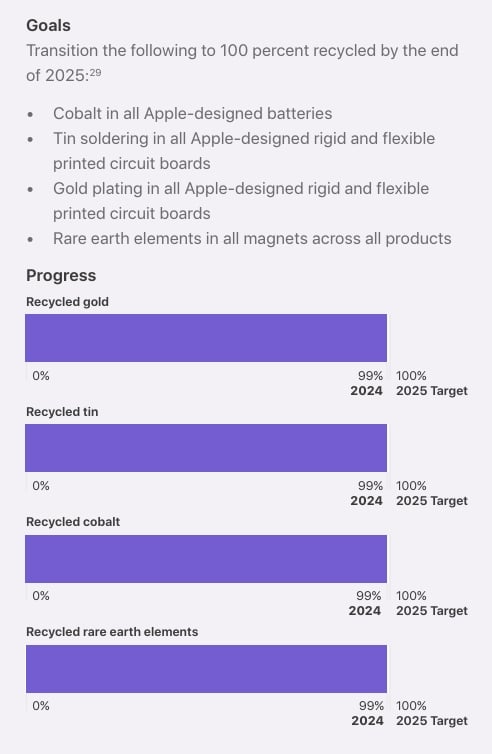
AI Partnerships Could Add Another Growth Driver
Reports suggest Apple is exploring partnerships with OpenAI and Anthropic to enhance Siri. If successful, these deals could strengthen Apple’s position in the fast-growing AI market.
Can U.S. Manufacturing Plans Keep the Rally Going?
Apple’s reshoring strategy could sustain momentum over the medium term. By resonating with Trump’s “America First” policies and reducing reliance on overseas suppliers, the company is lowering regulatory risks and earning political goodwill.
Nonetheless, challenges remain, but the long-term benefits could outweigh them by securing a more resilient supply chain.
From this analysis, it’s evident that Apple’s recent gains reflect a powerful combination of U.S. manufacturing investments, record earnings, sustainability leadership, and potential AI growth. By strategically aligning with domestic policy and building a stronger supply chain, the company is reducing uncertainty, which is one of the biggest drivers of investor confidence.
The post Apple: $94 Billion Record Earnings and the Breakthrough Climate Solutions Fueling Growth appeared first on Carbon Credits.
Carbon Footprint
U.S. DOE Reveals $1B Funding to Boost Critical Minerals Supply Chain
The U.S. Department of Energy (DOE) has announced a nearly $1 billion program to strengthen America’s supply of critical minerals and materials. The funding will support mining, processing, and manufacturing within the country. These materials power clean energy technologies and are vital for national security.
This funding builds on President Trump’s Executive Order to Unleash American Energy. It also supports the DOE’s wider Critical Minerals and Materials Program, which focuses on boosting U.S. production, expanding recycling, and strengthening supply chain security.
U.S. Secretary of Energy Chris Wright remarked:
“For too long, the United States has relied on foreign actors to supply and process the critical materials that are essential to modern life and our national security. Thanks to President Trump’s leadership, the Energy Department will play a leading role in reshoring the processing of critical materials and expanding our domestic supply of these indispensable resources.”
From Mines to Magnets: Where the $1B Goes
The DOE’s $1 billion plan targets key minerals like lithium, cobalt, nickel, and rare earth elements. These are essential for electric vehicle batteries, wind turbines, solar panels, and advanced electronics used in defense systems.
The funding is split across several areas:
- $500 million to the Office of Manufacturing and Energy Supply Chains (MESC) for battery material processing, manufacturing, and recycling projects.
- $250 million to the Office of Fossil Energy and Carbon Management to support facilities producing mineral byproducts from coal and other sources.
- $135 million to boost rare earth element production by extracting them from mining waste streams.
- $50 million to refine materials like gallium, germanium, and silicon carbide, which are crucial for semiconductors and high-performance electronics.
- $40 million through ARPA-E’s RECOVER program to extract minerals from industrial wastewater and other waste streams.
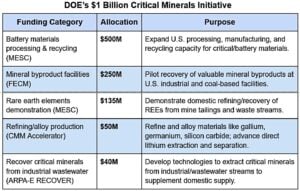
By investing from extraction to refining, the DOE aims to reduce reliance on foreign suppliers, especially those in politically unstable regions. The plan also encourages public–private partnerships to scale production faster.
Why Critical Minerals Matter for America’s Future
Critical minerals lie at the heart of America’s economic transformation and defense strategy. In recent years, demand for lithium, cobalt, nickel, and rare earth elements has grown. This rise comes as clean energy technologies become more important.
The U.S. imports more than 80% of its rare earth elements, and most of this comes from one country – China. This heavy reliance creates risks during trade or geopolitical tensions.
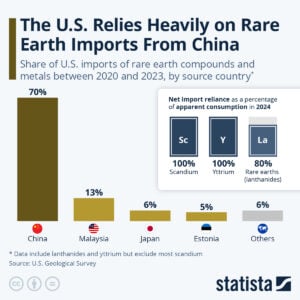
The Trump administration has placed strong emphasis on closing this vulnerability. In March 2025, an executive order highlighted critical minerals as vital for national defense. It also set timelines to boost U.S. production and processing capacity. This aligns with broader economic priorities, including clean energy jobs, green infrastructure, and domestic manufacturing.
The Inflation Reduction Act and infrastructure programs have unlocked billions in grants and tax credits. These funds support electric vehicle manufacturing, battery plants, and renewable energy projects.
The DOE’s $1 billion critical mineral fund supports programs by focusing on materials essential for the clean energy economy. Also, by reusing existing industrial facilities to recover minerals instead of building entirely new ones, the DOE can speed up progress and reduce costs.
EV production is expected to grow faster than any other sector, with demand for minerals likely to be more than 10x higher by 2050. This surge will transform the global supply chain and is critical for the global Net Zero aspirations.
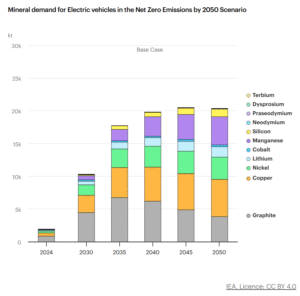
The combined impact of industrial strategy, financial incentives, and supply chain investments shows a clear push to:
- Move production back onshore,
- Boost innovation in materials recycling,
- Support the energy transition, and
- Cut down on foreign imports.
Building on Early Wins
The DOE’s new $1 billion investment boosts earlier funding for critical minerals. This aims to strengthen U.S. industrial capacity.
In 2023, the Department gave $150 million to various clean mineral projects. These include direct lithium extraction in Nevada and early-stage nickel processing partnerships in Oregon.
Since 2021, DOE has invested more than $58 million in research. This work focuses on recovering critical minerals from industrial waste or tailings. They are turning by-products into valuable feedstock.
These R&D projects created pilot facilities. They show how to recover lithium from geothermal brines and rare earths from coal ash. This approach models resource use without needing new mining.
Built on these early successes, the new $1 billion fund signals a shift from pilot programs to scaling proven technologies. It allows U.S. manufacturers to pivot from lab-scale experiments to full commercial operations.
For example, lithium recovery projects are moving from test sites to large extraction facilities. This shift is supported by the technical help from DOE’s national labs.
Likewise, battery recycling pilots are set to grow. More recycling centers are being planned in the Midwest and Southwest.
This funding approach provides continuity. It supports U.S. firms from basic research to commercialization. This helps them quickly move from proof-of-concept to production-ready operations. It also reassures private investors that government backing is strategic and sustained.
McKinsey projects that developing new copper and nickel projects will require between $250 billion and $350 billion by 2030. By 2050, the broader critical minerals sector could grow into a trillion-dollar market to support the net-zero or low-carbon transition.

Washington’s Backing, Industry’s Buy-In
Political backing for the domestic minerals strategy is strong. A recent executive order aims to speed up mining permits and provide federal support.
The Defense Department has also invested $400 million in MP Materials, the largest stakeholder in the only U.S. rare earth mine. This deal includes a new plant to produce magnets for electronics and defense applications.
Industry players are moving in the same direction. Battery maker Clarios is exploring sites for a $1 billion processing and recovery plant in the country. These moves show a shared goal between government and industry to rebuild America’s mineral supply chains.
Opportunities—and the Roadblocks Ahead
The DOE’s program offers major opportunities:
- Less reliance on foreign countries for essential materials.
- Creation of high-quality U.S. jobs.
- Growth in recycling and recovery technologies.
However, challenges remain. Mining and processing must be done without harming the environment. Technology costs need to stay competitive. And benefits must be shared fairly with local and Indigenous communities.
Amid all this, the global race for critical minerals is intensifying. Many countries are already securing their own supplies. The U.S. wants to close its supply gap and become a leader in clean energy manufacturing.
The DOE’s nearly $1 billion plan is a key step toward reshoring America’s critical minerals industry. It builds on earlier successes and aligns with private investments and new policies. If successful, it could make U.S. supply chains more secure, support the clean energy transition, and strengthen national security.
The post U.S. DOE Reveals $1B Funding to Boost Critical Minerals Supply Chain appeared first on Carbon Credits.
Carbon Footprint
Bitcoin Price Hits $124,000 Record High vs Ethereum Price Near $4,800: Which Crypto Is Greener?
Bitcoin price surged past $124,000 upon writing, setting a new all-time high. Analysts credit several factors:
- strong institutional buying,
- increased inflows into Bitcoin ETFs,
- favorable regulatory changes allowing crypto assets in 401(k) retirement accounts, and
- growing market optimism over expected Federal Reserve interest rate cuts.

The rally reflects both a recovery from previous market downturns and a renewed appetite for digital assets among mainstream investors.
Ethereum, the second-largest cryptocurrency by market capitalization, is also on the rise. It is now approaching its all-time high of around $4,800, last seen in November 2021.

Investor sentiment is rising because of Ethereum’s role in decentralized finance (DeFi) and NFT marketplaces. Its better environmental profile, thanks to the switch to a proof-of-stake (PoS) model, also helps.
With both tokens in focus, let’s look at their energy use and carbon footprint. This matters for investors and policymakers who care about their climate and environmental impact.
How Bitcoin’s Proof-of-Work Consumes Energy
Bitcoin’s network runs on a process called proof-of-work (PoW). Miners around the world compete to solve complex mathematical puzzles. The first to solve it gets to add a block of transactions to the blockchain and earn newly minted Bitcoin. This process secures the network but demands enormous computing power.
That computing power uses a lot of electricity. Bitcoin’s annual energy use is estimated at about 138–178 terawatt-hours (TWh). This is similar to the electricity consumption of countries like Poland or Thailand, and even greater than Norway.
The carbon footprint is equally large, at around 40 million tonnes of CO₂ equivalent per year. To put that into perspective, that’s similar to the emissions of Greece or Switzerland.
On a per-transaction basis, a single Bitcoin payment can use as much energy as a typical U.S. household does in one to two months.
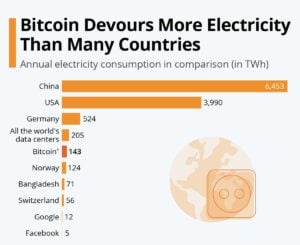
Beyond electricity, Bitcoin mining also generates significant electronic waste. Specialized mining hardware, called ASICs, becomes obsolete quickly—often within two to three years—because faster, more efficient models keep being developed. This turnover contributes thousands of tonnes of e-waste annually.
Ethereum’s Post-Merge Energy Transformation
Before 2022, Ethereum also used proof-of-work, with high energy demands. But in September 2022, the network completed the Merge, switching to proof-of-stake.
Ethereum now uses validators instead of miners. These validators “stake” their ETH tokens as collateral. This helps confirm transactions and secure the network.
This change cut Ethereum’s energy use by over 99.9%. Today, the network consumes an estimated 2,600 megawatt-hours (MWh) annually—roughly 0.0026 TWh. That’s less electricity than a small town of 2,000 homes might use in a year.
The carbon footprint is also tiny compared to Bitcoin—under 870 tonnes of CO₂ equivalent annually. That’s about the same as the yearly emissions of 100 average U.S. households. In environmental terms, Ethereum has gone from being one of the largest blockchain energy consumers to one of the most efficient.

Beyond Electricity: Hidden Environmental Costs
While electricity use is the biggest factor, it’s not the only environmental concern for both cryptocurrencies. Here are the other environmental impacts:
- Water Use:
Large-scale Bitcoin mining facilities often require substantial cooling, which can consume millions of liters of water annually. This can put pressure on local water supplies, particularly in drought-prone regions. Ethereum’s low energy profile greatly reduces such needs. - Heat Output:
Mining facilities generate significant heat. In some cases, waste heat is reused for industrial or agricultural purposes, but in most situations, it is simply released into the environment, adding to local thermal loads. - Land and Infrastructure:
Bitcoin mining operations require large warehouses and access to high-capacity electrical infrastructure. This can limit available industrial space for other uses and put stress on local grids.
By using proof-of-stake, Ethereum avoids most of these impacts. It just needs standard server equipment. This can run in data centers with other low-impact computing tasks.

How the Industry Is Addressing Bitcoin’s Footprint
The crypto industry is aware of Bitcoin’s environmental challenges and is taking steps to address them. Some of the actions taken include:
- Renewable Mining: Some mining operations use only hydro, wind, or solar energy. This is common in areas with plenty of renewable resources.
- Waste Heat Recovery: A few miners capture and reuse waste heat for agriculture (e.g., greenhouse farming) or district heating systems.
- Carbon Offsetting: Companies and mining pools are buying carbon credits to offset emissions. However, how well this works depends on the quality of those credits.
- Policy Proposals: Governments may require Bitcoin miners to share their energy sources or meet renewable energy goals.
SEE MORE: Top 5 Sustainable Bitcoin Mining Companies To Watch Out For
While these efforts are promising, the core challenge remains: proof-of-work’s high energy requirement is built into Bitcoin’s security model.
Why This Matters for ESG-Minded Investors
For investors who care about environmental, social, and governance (ESG) factors, the difference between Bitcoin and Ethereum is stark. Ethereum’s low-energy proof-of-stake model makes it easier to align with climate goals. Bitcoin’s high energy use and emissions, while partially mitigated by renewable adoption, remain a significant concern.
These factors may influence where ESG-focused funds allocate capital. Companies and institutions wanting exposure to blockchain technology without a large carbon footprint might prefer Ethereum or other PoS networks.
Bitcoin may still attract investors because of its market dominance and value as a store. However, it will likely keep facing environmental concerns.
The Road Ahead for Crypto and Climate
Bitcoin and Ethereum’s price rallies show that investor interest in crypto remains strong. As climate change and sustainability gain importance in policy and investment, environmental performance may play a larger role in the long-term value and acceptance of digital assets.
For now, Ethereum sets the standard for energy efficiency among major blockchains, while Bitcoin represents the ongoing challenge of balancing security, decentralization, and sustainability. Can Bitcoin cut its environmental impact without losing its key features? This will be an important question in the coming years.
The post Bitcoin Price Hits $124,000 Record High vs Ethereum Price Near $4,800: Which Crypto Is Greener? appeared first on Carbon Credits.
-
Climate Change2 years ago
Spanish-language misinformation on renewable energy spreads online, report shows
-
Climate Change Videos2 years ago
The toxic gas flares fuelling Nigeria’s climate change – BBC News
-

 Greenhouse Gases1 year ago
Greenhouse Gases1 year ago嘉宾来稿:满足中国增长的用电需求 光伏加储能“比新建煤电更实惠”
-

 Climate Change1 year ago
Climate Change1 year ago嘉宾来稿:满足中国增长的用电需求 光伏加储能“比新建煤电更实惠”
-

 Carbon Footprint1 year ago
Carbon Footprint1 year agoUS SEC’s Climate Disclosure Rules Spur Renewed Interest in Carbon Credits
-
Climate Change2 years ago
Why airlines are perfect targets for anti-greenwashing legal action
-
Climate Change Videos2 years ago
The toxic gas flares fuelling Nigeria’s climate change – BBC News
-
Climate Change2 years ago
Some firms unaware of England’s new single-use plastic ban


